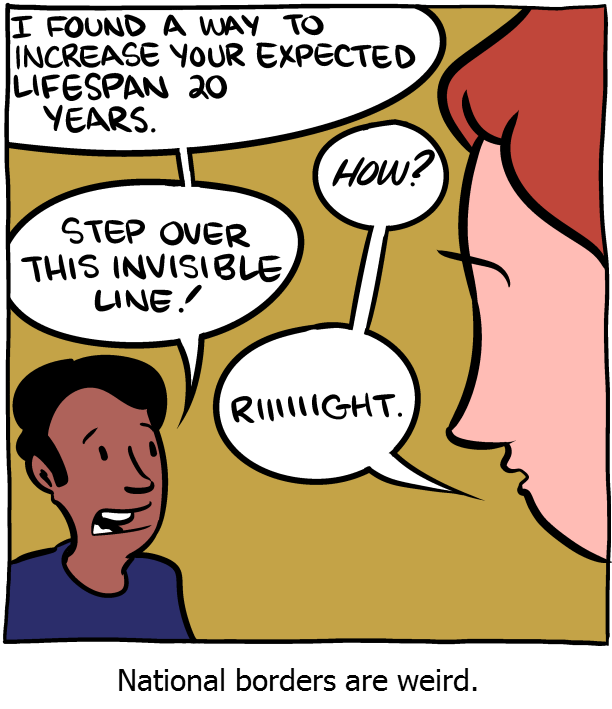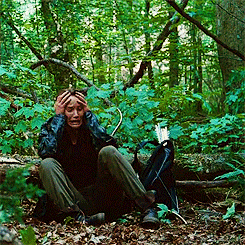Folded beds of (I think) Flournoy Formation- very similar in appearance to the Tyee- along the Umpqua River, near Roseburg, Oregon. (Right click on the photo here for various size options) While this is near the suture between the Siletz (Coast Range) block and the Klamath-Siskyou Province, and it is tightly folded with some thrusting, the deformation does not seem to be tectonic in origin. It appears to be confined to a fairly small area, maybe a square mile, and though the boundaries have not been tightly constrained, the transition from deformed to undeformed is apparently quite abrupt. This is thought to be more likely something like an olistostrome, an underwater slump.
Photo stitched in Hugin, otherwise unmodified. July 2, 2013. FlashEarth location.
Miscellaneous thoughts on politics, people, math, science and other cool (if sometimes frustrating) stuff from somewhere near my favorite coffee shop.
Saturday, July 6, 2013
Friday, July 5, 2013
Geo 365: July 5, Day 186: Jointed Sandstone
A well-cemented, quite competent sandstone bed is preferentially weathering along a set of joints, forming an abstract mosaic at Beverly Beach State Park, Lincoln County, Oregon. The rock here is Miocene Astoria Formation. Right click the photo for various size options here. Below is a photo of Chris Rowan (@Allochtonous) for scale.
Photo stitched in Hugin, otherwise unmodified. July 3, 2013. FlashEarth location.(Astonishingly, you can resolve the pits where blocks have been pounded loose and out by waves in the FE image!)
Photo stitched in Hugin, otherwise unmodified. July 3, 2013. FlashEarth location.(Astonishingly, you can resolve the pits where blocks have been pounded loose and out by waves in the FE image!)
Thursday, July 4, 2013
Geo 365: July 4, Day 185: Tyee Turbidites
An enormous panorama (8032 x 2024) of an outcrop of Tyee turbidites, just east of Eddyville, OR. The above image is linked to the full-sized image, hosted at Flickr; alternatively, you can view the image here, and right click on it for various size options.
Soon after the oceanic plateau/seamount terrane of the Siletz River Volcanics formed (Siletzia), its (now) southern (then eastern) end moved to within close enough proximity to North America that the area began to receive and accumulate continental sediment from the Klamath Mountain region. As the docking process initiated and continued, these sediments accumulated to greater thickness in the Roseburg area, where Chris Rowan (@Allochthonous) and I visited them on Tuesday.
The drainage supplying that sediment apparently captured a large stream that was eroding the Idaho Batholith, and the nature of the sediment changed from dominantly lithics (the Flournoy Formation) to sands dominated by feldspar and mica (the Tyee Formation), as one would expect from a granitic landscape. This new sediment accumulated in a large deltaic fan. Occasionally, perhaps on the order of decades to centuries, a portion of that fan would collapse and slide into deeper water. These so-called turbidites might have been triggered by earthquakes, unusually large storms, or simply by over-steepening of the sediment pile.
As they moved downhill, these submarine slides would disaggregate, entrain water, and become what I describe as underwater sand and dust storms. The turbid water rushed down the slope until it reached the bottom, where it ran out of energy and the sediment began to settle out. The coarsest material, the sands, settled out first, in a matter of hours to maybe a day or so, followed by finer silts and muds over a period of days to weeks and months. So turbidites generally, and the above specifically, are characterized by rhythmically stacked couplets of sandstone and mudstone, repeating thousands of times through the entire sequence. Though we're only seeing around a dozen of these couplets in the above outcrop, it provides an impressive window into the history of the Oregon Coast Range. @Allochthonous, in the lower center provides a sense of scale.
Photo stitched in Hugin, otherwise unmodified. July 3, 2013. FlashEarth location
Soon after the oceanic plateau/seamount terrane of the Siletz River Volcanics formed (Siletzia), its (now) southern (then eastern) end moved to within close enough proximity to North America that the area began to receive and accumulate continental sediment from the Klamath Mountain region. As the docking process initiated and continued, these sediments accumulated to greater thickness in the Roseburg area, where Chris Rowan (@Allochthonous) and I visited them on Tuesday.
The drainage supplying that sediment apparently captured a large stream that was eroding the Idaho Batholith, and the nature of the sediment changed from dominantly lithics (the Flournoy Formation) to sands dominated by feldspar and mica (the Tyee Formation), as one would expect from a granitic landscape. This new sediment accumulated in a large deltaic fan. Occasionally, perhaps on the order of decades to centuries, a portion of that fan would collapse and slide into deeper water. These so-called turbidites might have been triggered by earthquakes, unusually large storms, or simply by over-steepening of the sediment pile.
As they moved downhill, these submarine slides would disaggregate, entrain water, and become what I describe as underwater sand and dust storms. The turbid water rushed down the slope until it reached the bottom, where it ran out of energy and the sediment began to settle out. The coarsest material, the sands, settled out first, in a matter of hours to maybe a day or so, followed by finer silts and muds over a period of days to weeks and months. So turbidites generally, and the above specifically, are characterized by rhythmically stacked couplets of sandstone and mudstone, repeating thousands of times through the entire sequence. Though we're only seeing around a dozen of these couplets in the above outcrop, it provides an impressive window into the history of the Oregon Coast Range. @Allochthonous, in the lower center provides a sense of scale.
Photo stitched in Hugin, otherwise unmodified. July 3, 2013. FlashEarth location
Wednesday, July 3, 2013
Geo 365: July 3, Day 184: Highly Allochtonous Pillows
@Allochthonous and @HighlyAnne standing in front of pillow basalts (which are also allochthonous) on Marys Peak, Oregon. The heat has been oppressive since last Friday, but we're headed over to the coast today- highs should be around 70 there- and the heat wave is expected to start to break tomorrow. The highly allochthonous megaventure continues...
Photo unmodified. July 1, 2013. FlashEarth location.
Photo unmodified. July 1, 2013. FlashEarth location.
Tuesday, July 2, 2013
Geo 365: July 2, Day 183: Tidepools?
Pretty clearly, what the BLM expected to be here, isn't. Rather than a tidepool, this is a beach.
Chris (@allochtonous) and Anne (@highlyanne) are in town. Yesterday, we went up Marys Peak for a quick overview of big-picture Coast Range geohistory (and to escape the heat); today, we're headed down to Roseburg to see some of the stratigraphy that was emplaced before the Tyee Formation (Eocene turbidites) and after the seafloor/oceanic plateau basalts that form the basement rock of westernmost Oregon. Rocks in that interval were not deposited in this area. At any rate, I'm likely to interrupt this segment on Yaquina Head again, when I get photos transferred from my camera to my laptop.
Photo unmodified. March 7, 2012. FlashEarth location.
Chris (@allochtonous) and Anne (@highlyanne) are in town. Yesterday, we went up Marys Peak for a quick overview of big-picture Coast Range geohistory (and to escape the heat); today, we're headed down to Roseburg to see some of the stratigraphy that was emplaced before the Tyee Formation (Eocene turbidites) and after the seafloor/oceanic plateau basalts that form the basement rock of westernmost Oregon. Rocks in that interval were not deposited in this area. At any rate, I'm likely to interrupt this segment on Yaquina Head again, when I get photos transferred from my camera to my laptop.
Photo unmodified. March 7, 2012. FlashEarth location.
Monday, July 1, 2013
Geo 365: July 1, Day 182: Quarry Cove
As I mentioned yesterday, this was a basalt quarry, the rock presumably crushed for road gravel. The trench was roughly parallel to the coastline. When it was retired, BLM, which manages Yaquina Head, decided to breach the western end to the shore, allowing waves and tides free entry to the quarry. Then, building a series of ramps and walkways, they would create a unique handicapped-accessible set of tidepools and all the fascinating lifeforms therein. It sounded great in theory, and truly was a clever and well-intentioned idea, but they should have a geologist- any geologist, really- look over the proposal and site before implementing it.
Photo unmodified. March 7, 2012. FlashEarth location.
Photo unmodified. March 7, 2012. FlashEarth location.
Sunday, June 30, 2013
Sunday Funnies: DOMA Edition
Bits and Pieces
Are You Talking to Meme?
Sober in a Nightclub
Criggo
Bizarro
Blackadder
Happle Tea
Bizarro
Are You Talking to Meme?
Savage Chickens
Matt Bors
"When I realize I forgot to include controls" What Should We Call Grad School?
Funny to Me
What Would Jack Do?
Fake Science
One of a number of "Bearded dragons wearing hats," at Tastefully Offensive
Wil Wheaton's Tumblr
Cyanide and Happiness
Cheezburger
Criggo
"Thirty Years Later" Bits and Pieces
Matt Bors
ChannelATE
Senor Gif
See Mike Draw
Cheezburger
Funny to Me
Clay Bennett
SMBC
"How I feel on day 3 of our mapping project and I still can't find a decent outcrop" Geology is Hard
PhD Comics
Powerfully curious about what, exactly, she was given to taste. Senor Gif
Blackadder
Are You Talking to Meme?
Sober in a Nightclub
Criggo
Bizarro
Blackadder
Happle Tea
Bizarro
Are You Talking to Meme?
Savage Chickens
Matt Bors
"When I realize I forgot to include controls" What Should We Call Grad School?
Funny to Me
What Would Jack Do?
Fake Science
One of a number of "Bearded dragons wearing hats," at Tastefully Offensive
Wil Wheaton's Tumblr
Cyanide and Happiness
Cheezburger
Criggo
"Thirty Years Later" Bits and Pieces
Matt Bors
ChannelATE
Senor Gif
See Mike Draw
Cheezburger
Funny to Me
Clay Bennett
SMBC
"How I feel on day 3 of our mapping project and I still can't find a decent outcrop" Geology is Hard
PhD Comics
Powerfully curious about what, exactly, she was given to taste. Senor Gif
Blackadder
Geo 365: June 30, Day 181: Columnar Quarry
Columnar jointing in the walls of a defunct quarry, the so-called Quarry Cove on Yaquina Head. This quarry was active until maybe 15-20 years ago. When it was taken over by the BLM, and added to the scenic area, they decided to create an artificial tide pool area, accessible to wheelchairs. Great concept, but as we'll see in coming days, poorly thought out.
Photo unmodified. March 7, 2012. FlashEarth location.
Photo unmodified. March 7, 2012. FlashEarth location.




































